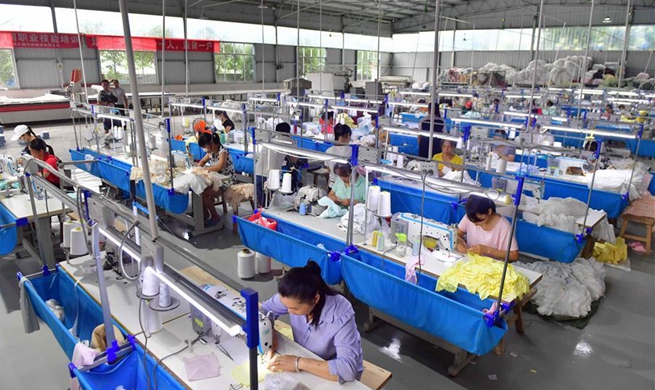BEIJING, July 16 (Xinhua) -- East China's Shandong Province is giving full play to its advantages in developing the marine economy as it switches gear to new growth drivers, provincial officials said Tuesday.
"Shandong saw marine economy output grow to 1.55 trillion yuan (about 225.4 billion U.S. dollars) last year, up from less than 20 billion yuan in 1991," provincial Communist Party Chief Liu Jiayi said at a press conference regarding the coastal region's new growth momentum.
The figure accounted for over 20 percent of the country's total and spoke volumes of Shandong's commitment to taking the lead in boosting the country's maritime economic power.
Home to one-sixth of China's coastline, Shandong is endowed with rich marine resources and has the lion's share of talent and experts in marine science and technology. It is also the only provincial-level region that has three ports with annual throughput surpassing 400 million tonnes.
Shandong is working on three major tasks as a marine economy pioneer: faster creation of world-class ports, establishing a fully-fledged modern marine industry system and building sustainable maritime ecology and environment, said Shandong's governor Gong Zheng.
A conglomerate has been created to integrate three major ports in the Bohai Bay area, and a new group is being created for the tie-up of Qingdao port and Weihai port, he said.
Meanwhile, the Jiaodong Peninsula is being developed into a regional transport hub in northeast Asia, with a major step taken after a cooperation deal reached between Shandong and Incheon, Republic of Korea in March, Gong said.
In terms of the modern marine industry system, vigorous efforts are being made to develop the industrial cluster of marine equipment manufacturing, ocean engineering and marine biomedicine, the governor said.
For Shandong, the birthplace of Confucius and a provincial-level economic heavyweight, a booming marine economy mirrors redoubled efforts in switching to new economic dynamos.
Some 70 percent of the Shandong's industrial output came from traditional industries, of which heavy chemical industry accounted for about 70 percent, according to Liu, who compared Shandong's advance toward high-quality development to "vacating the cage and changing the bird" and the "nirvana of the phoenix."
Change in the economy has gained momentum after Shandong was given go-ahead in building the country's first comprehensive pilot zone of transition from old to new growth drivers at the beginning of 2018. The province vowed to achieve breakthroughs within five years.
Added value generated by new growth drivers accounted for 48 percent of Shandong's GDP, up from 39 percent in 2016, Liu said. "Traditional and backward production capacity is declining, while that of new growth drivers and high-tech industries is growing faster."
According to Shandong's plan, the modern marine economy will be one of its top 10 competitive industrial clusters, which gives priority to industries such as new-generation information technologies, high-end equipment and new energy and materials.
The added value of Shandong's modern marine industries is expected to exceed 2.3 trillion yuan in 2022 or over 23 percent of the provincial GDP, Gong said.

















